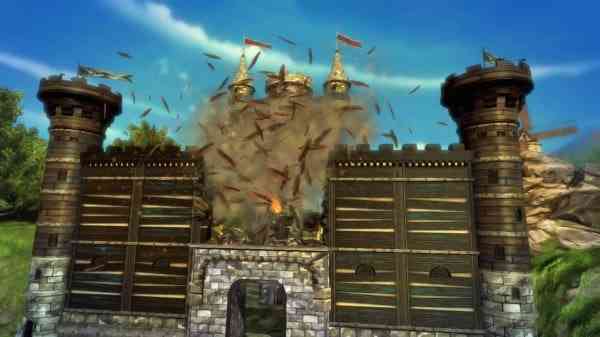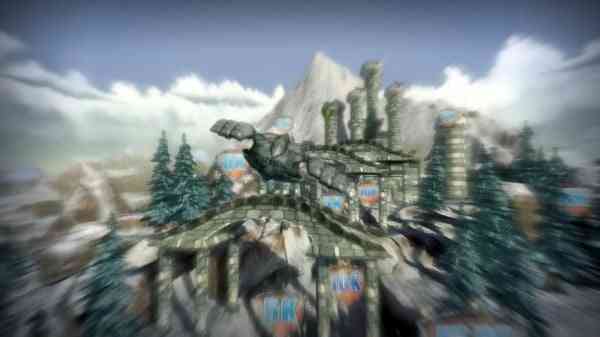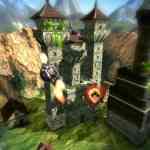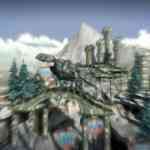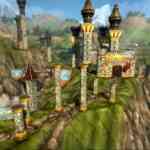My first introduction to Wreckateer was during the annual madness known as E3. As I watched the demo on stage at Microsoft’s Press Conference I was somewhat skeptical of what the game had to offer, and I questioned whether or not Microsoft’s motion sensor would be adequate enough for such a puzzle game. Well, I have had some time to play the final XBLA version, and although the game is far from perfect, I think that this game deserves a look for those looking for something new for their Kinect.
You are a new member of a team of three Wreckateers, hence the name of the game. Your team is in charge of using a ballista to wreck enemy structures. For those wondering what a ballista is, it is a weapon that was developed by the ancient Greeks. It launches a projectile by using levers and springs. In many ways it is a high tech slingshot as you pull back to get your power, aim and release. Your AI teammates teach you the basics of control as you learn how to destroy enemy castles and their surroundings, including those that happen to be inside or around it. Many people will compare this game to the highly addictive and highly successful game Angry Birds, but what makes this game different is not on the setting but the use of the Kinect.
As you make your way through the 60 or so levels, you’ll find that there are different shots that you need to make with different types of ammo. From bomb shots that detonate where you want, a winged projectile that you guide by putting our your arms out and move to steer, to a split shot that spreads into four mini projectiles, there are quite a few different types of shots that you can use to be successful. Where Wreckateer throws a bit of a challenge at you is that you don’t have access to all types of shots for each level, as there are a pre-determined set of shots for you to take. You do not know which types of shot the game will give you as you head on to the next level. So you will have to don your thinking cap and figure out which shots are the ones that you should use to get the best result.
To launch your projectile you literally put your arms out in front of you, take a few steps back to set your power, move your arms to aim, and release. But you are not done there. After you launch your shot you can put a bit of ‘English’ on your shot as it flies through the air and you will also activate your special shots (e.g. wings or split shot). Not only do you try to guide your projectile into the towers, turrets, and walls of your enemy’s castles, but you can also try to hit power ups that are in the area, score multipliers, and even hit bundles of dynamite that add some explosive punch.
Your reward comes in taking down all the structures, knocking out all the enemies, and making some pretty good trick shots in order to reach the score multipliers and finding that one special spot that creates a chain reaction to destroy everything on screen. There is a leaderboard that you can watch as you try to beat your friend’s scores or you can aim high and try to be on top of the world scores.
Each level has certain scores that you have to reach in order earn a bronze, silver or gold rating. As you play the early levels you will find that you can meet many of these scores, but as you get into the later levels you will come across a level or two that throws more then a few curveballs to make the difficulty spike. You will find yourself playing a few levels over more than a few times just to reach the bronze level.
Wreckateer’s Kinect controls are fairly simple, and in the end it is more responsive then I thought it would be. I have struggled in the past with many Kinect games, but in Wreckateer the Kinect performed admirably. Although I came across a hiccup now and then, overall I did not find many of the issues that I have ran into in the past with Kinect enabled games. This is a game that plays quite well with the Kinect and I think many owners of Microsoft’s motion sensing peripheral will be happy here.
Something that became quite evident during my time with Wreckateer is that this is a game that should not be played in long stretches, and should be played in short bursts. This is due to the game feeling repetitious. Although it can be addicting at times, many will find that they will want to stop playing more sooner than later, not because it is a bad game but because they will find themselves doing much of the same. I think many will appreciate it even more if they play in short bursts.
Visually the game is solid. With interesting level design, a good use of special effects (e.g. explosions, blur effects, etc.), and a good representation of castles and towers falling down, many should have no problems in the visuals department. As for the sound, it manages to highlight what the game is all about. From the sound of your ballista creaking as you pull it back, the thud as you release your projectile, to the sound of all your enemy’s structures crumbling and topping over due to a well placed shot, there is nothing to complain here. Oh yeah, the enemy voice work sounds good too. All and all the visuals and sound help add to the gameplay experience.
In the end Wreckateer shows that a causal puzzle game played with the Kinect can be enjoyable. I am sure that many will complain about the lack of being able to us a traditional controller, but once you experience the simplicity and ease of the Kinect controls, it just makes sense. I do have say though that the game can be repetitive and there is not a lot of incentive to play once your done; however, given the affordable price of 800 MS Points, Kinect owners may just want to take a serious look at this downloadable title.
